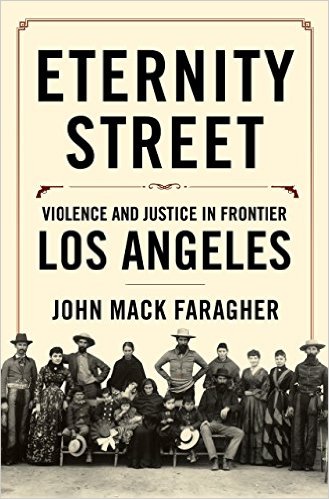 Eternity Street: Violence and Justice in Frontier Los Angeles
Eternity Street: Violence and Justice in Frontier Los Angeles
Author: John Mack Faragher
Publisher: W. W. Norton & Company
ISBN-10: 0-3930-5136-6
ISBN-13: 978-0-3930-5136-0
I am a lifelong resident of Los Angeles. There is very little published about the history of this city; nothing to match the few 1850s issues of the Los Angeles Star that I read in college. I got this hoping for at best a summary of some of the more lurid events in the two or three decades after Los Angeles passed from Mexican into American hands.
Instead, I found a detailed scholarly study that is mostly about 1850’s to 1880’s violence in Los Angeles, but that also covers the entire history of Alta California from its Spanish settlements in 1769 through its evolution to what passed by the 1880s for a standard American large city. Events that are usually briefly summarized in a couple of paragraphs in other books get whole chapters here. I may be prejudiced because of special interest, but I found Faragher’s clear writing difficult to put down. There are 16 pages of sharply reprinted photographs on glossy paper to illustrate all the main characters.
Carlos III of Spain established the settlement of California in 1769 to protect Spain’s North American colonies from British and Russian expansion. Yet there was so little contact between the few towns around San Francisco and Southern California (Los Angeles and San Diego) and Central Mexico that when Mexico became independent from Spain in 1821, the Californios practically considered themselves a separate nation rather than a part of Mexico. During the 1840s everyone in Alta California was so sure that the U.S. would “play the Texas game” – encourage a small group of U.S. settlers to proclaim an independent republic, then admit it to the U.S. and send the U.S. Army to enforce the land grab – that some leading Californians asked Britain or France to annex California from Mexico to protect it from the Americans.
There are about 110 pages on the U.S. acquisition of California from Mexico from 1845 to 1850, detailing more infighting among the top Americans (General Kearney, Colonel Frémont, Commodore Stockton) over who would get to be the military Governor of California, and battles between the Americans and the Californios, than between the Americans and the Mexicans (they had written off California from the start and never tried to defend it).
All of this is a prelude to the book’s main topic: frontier justice, meaning vigilante mobs and lynch law, in Los Angeles from 1850 to the late 1870s. This also covers the majority attitude among Los Angelinos to the Civil War during 1861 to 1865 (very pro-Southern). There were lynch mobs around San Francisco in the 1850s, too, but they lasted longer around Los Angeles. Faragher relates many cases in detail; naming the characters, why the townsfolk felt that vigilante justice was superior to official law, the L.A. newspapers editorializing pro and con, and their individual results; and why vigilantism became passé after 1880.
“Eternity Street” (named for Calle de Eternidad, the 1850s main street that led to the city cemetery) is a must-read for anyone interested in a deeper history of the growth of the American West than just the famous Wild West towns and their sheriffs and outlaws. $35.00, 624 pages, photographs and maps. Faragher is a professor of history at Yale University.





